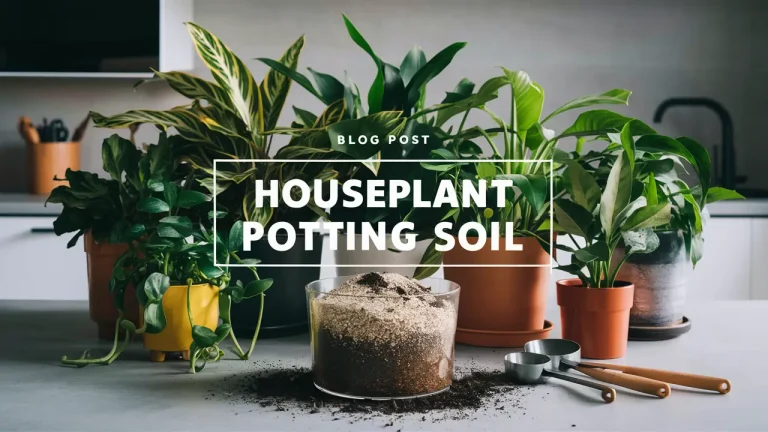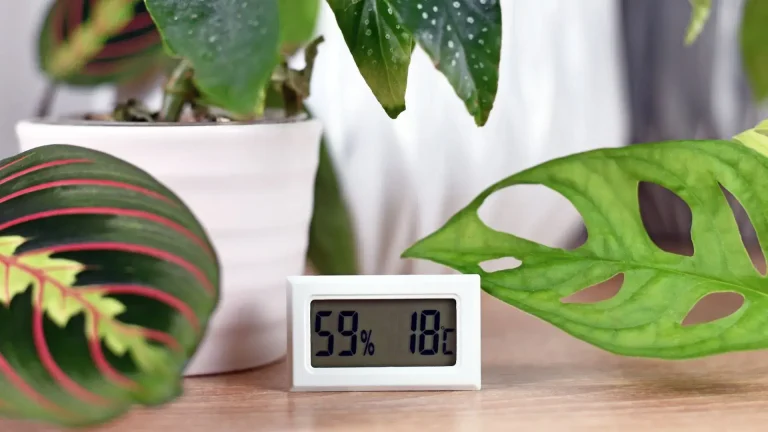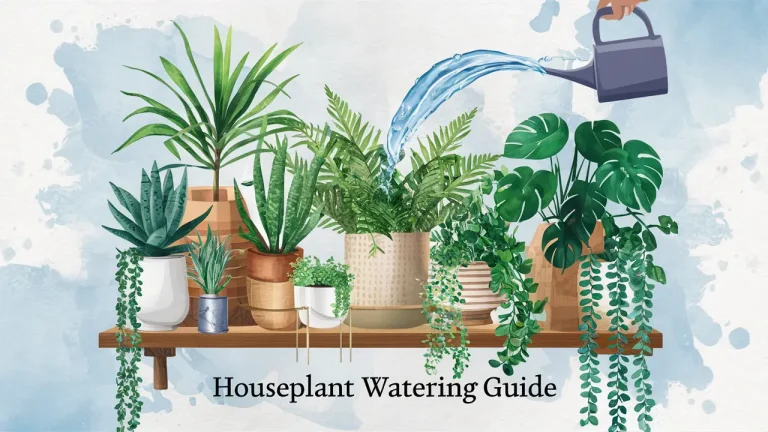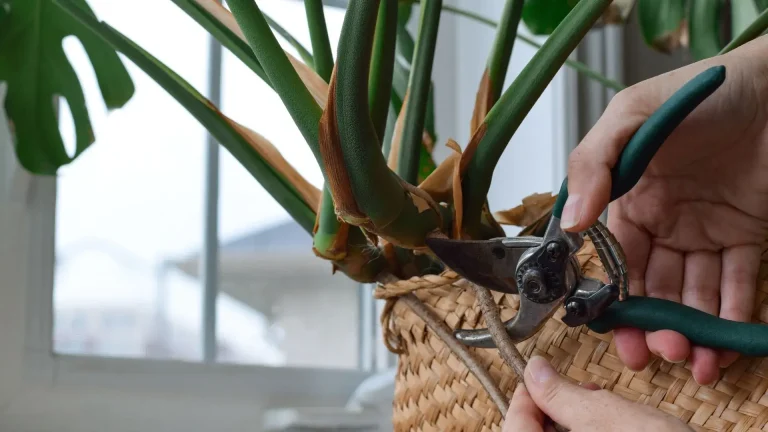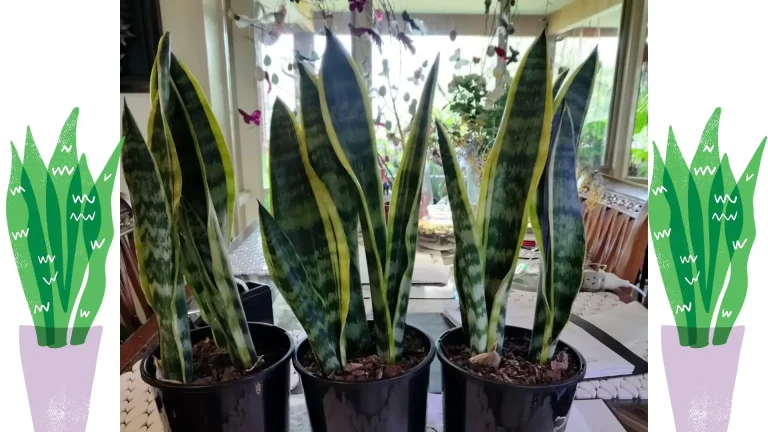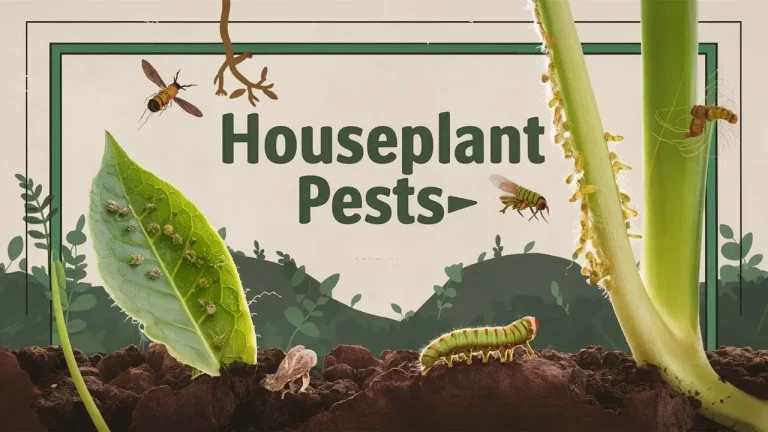Houseplant Lighting Made Easy-The Only Guide You’ll Ever Need
Different plants thrive under varying light conditions, and understanding these needs will empower you to make informed decisions when selecting plants for your home. In this houseplant lighting guide, we will explore the different types of light that houseplants require, the significance of light in photosynthesis, and how window orientation affects light availability.
Table of Contents
Why is Light So Important?
Light is the lifeblood of plants. Through the process of photosynthesis, plants convert light energy into the chemical energy they need to grow, bloom, and thrive. In nature, plants have evolved to flourish in specific light conditions. When we bring them indoors, it becomes our responsibility to recreate those conditions as closely as possible. Without adequate light, even the hardiest plants will struggle to survive.
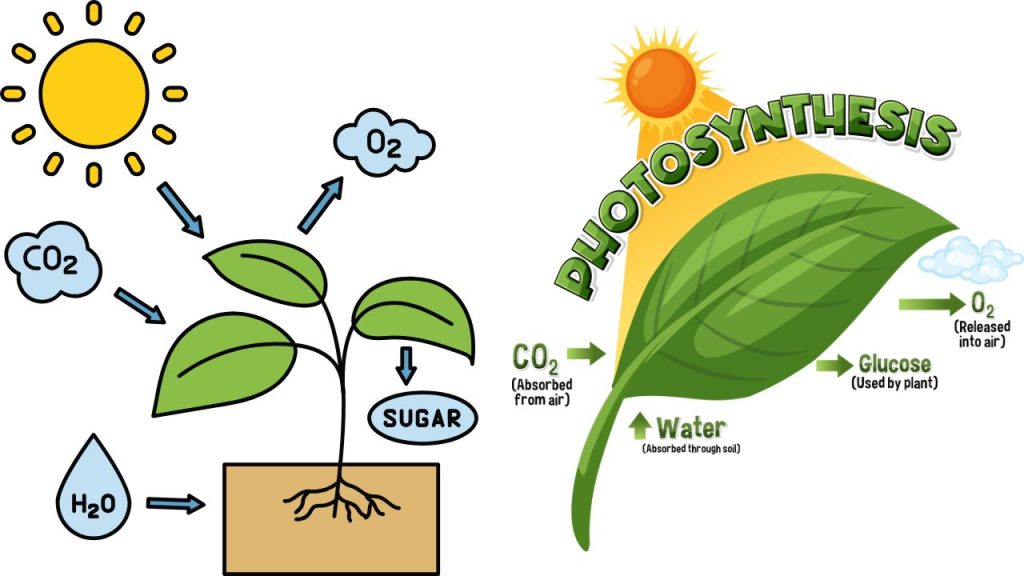
Understanding Light Types 🌞
Not all light is created equal when it comes to houseplants. Different plants have unique lighting preferences, and understanding these categories can help you choose the best spot for your greenery.
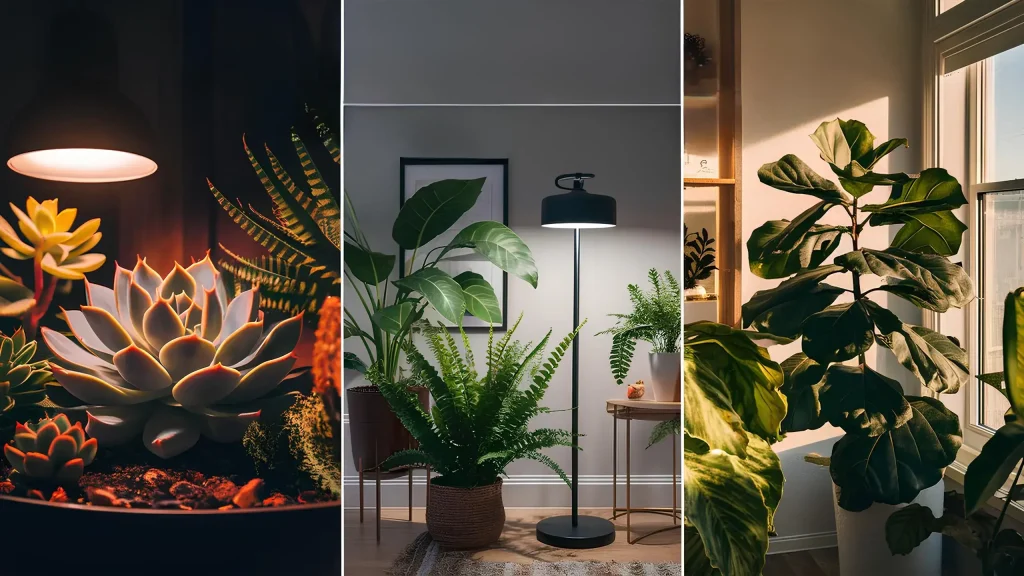
👉 Bright Direct Light
Bright direct light refers to sunlight that directly hits your plants, usually through unobstructed windows. These spots are typically found on south-facing window sills or areas where the sun streams in most of the day.
Best Locations:
- South-facing windows
- Unshaded patios or balconies
Best Plants for Bright Direct Light:
Plants that thrive in these conditions are often desert natives or sun-loving species, including:
- Succulents (e.g., echeveria, jade plants)
- Cacti (e.g., saguaro, golden barrel cactus)
- Bird of paradise
- Hibiscus
👉 Bright Indirect Light
Bright indirect light is the sweet spot for most houseplants. It’s bright enough to support growth but gentle enough to avoid scorching delicate foliage. This light is diffused, often by curtains, blinds, or being slightly removed from the window.
Characteristics:
- No direct sun rays on the plant
- Bright but not intense
Best Locations:
- A few feet away from a south-facing window
- Next to an east-facing window where morning sunlight is softer
- Rooms with filtered light through sheer curtains
Recommended Plants:
- Pothos
- Monstera
- Peace lilies
- Philodendrons
👉 Medium Light
Medium light, also known as partial shade or filtered light, is slightly dimmer than bright indirect light but still adequate for many hardy plants. These areas may have light that is blocked by trees, buildings, or furniture, creating a softer glow.
Examples of Medium-Light Conditions:
- Rooms with windows that receive light for part of the day
- Areas with filtered light from blinds or trees outside
Suitable Plants:
- Snake plants
- Spider plants
- Calathea
- Dracaena
👉 Low Light
Low light doesn’t mean no light—it refers to areas that receive minimal indirect light, such as north-facing rooms or spaces far from windows. While these conditions might seem challenging, many plants can adapt beautifully.
Typical Low-Light Environments:
- North-facing windows
- Rooms with heavy shading or limited natural light
- Hallways and corners
Best Options for Low-Light Plants:
- ZZ plant
- Cast iron plant
- Peace lily
- Parlor palm
✅ Pro Tip: Low light doesn’t mean NO light. These plants need at least some indirect ambient illumination to survive.
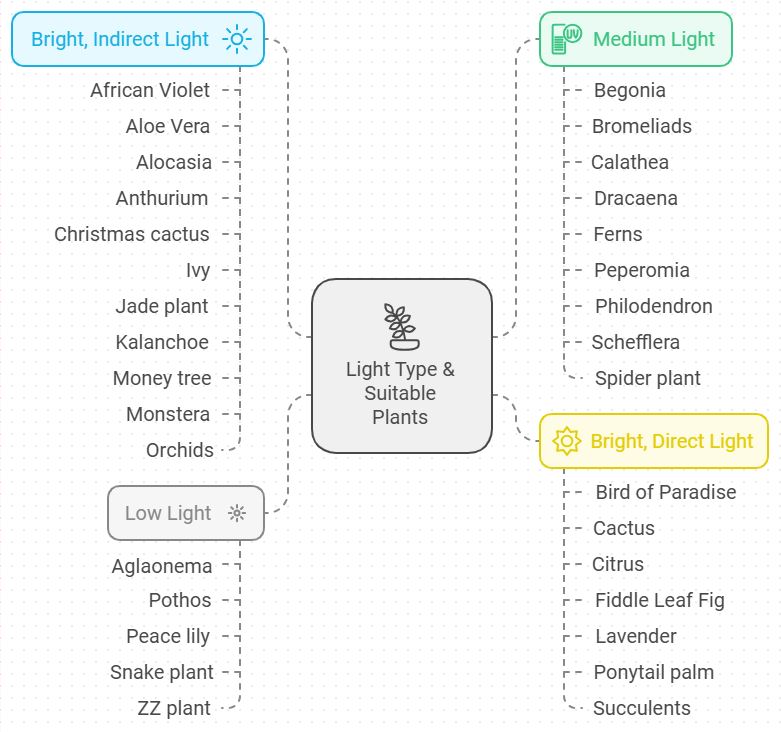
Windows Direction and Light Characteristics 🪟
The direction your windows face plays a significant role in determining the amount and quality of light that enters your home. Understanding how different window orientations affect sunlight can help you position your houseplants for optimal growth. Here’s a breakdown of the sunlight characteristics associated with each window direction:
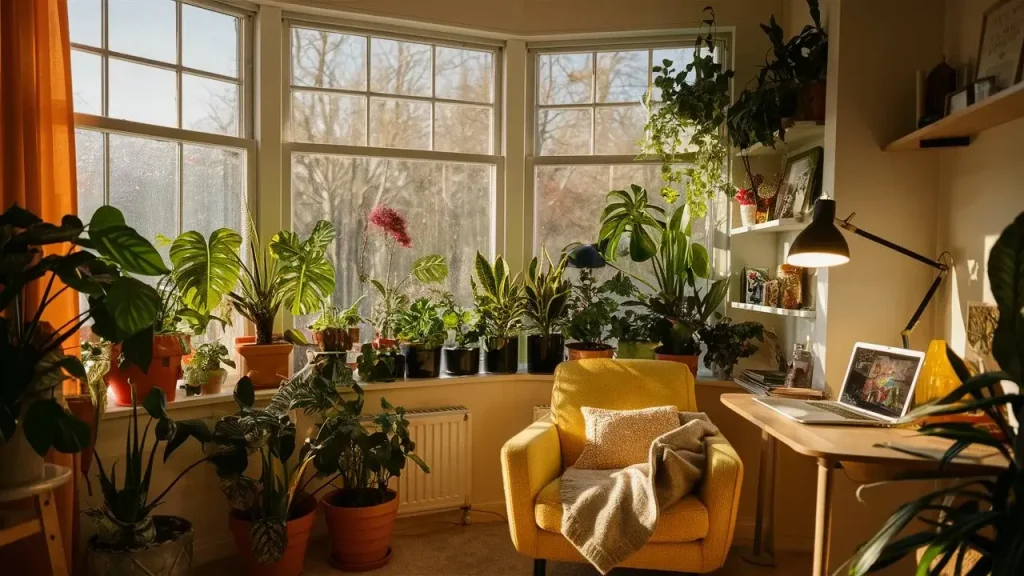
1. North-Facing Windows
Light Characteristics: North-facing windows receive the least amount of direct sunlight throughout the day, resulting in cooler, softer light. This type of light is often considered low to medium intensity.
Suitable Plants:
- Snake Plant (Sansevieria)
- ZZ Plant (Zamioculcas zamiifolia)
- Pothos (Epipremnum aureum)
- Peace Lily (Spathiphyllum)
✅ North-facing windows are ideal for plants that thrive in low-light conditions, as they provide gentle illumination without the risk of scorching leaves.
2. South-Facing Windows
Light Characteristics: South-facing windows receive the most direct sunlight, making them ideal for sun-loving plants. These windows typically provide bright, intense light for most of the day.
Suitable Plants:
- Cacti
- Succulents (e.g., Echeveria, Haworthia)
- Fiddle Leaf Fig (Ficus lyrata)
- Bougainvillea
✅ Plants placed near south-facing windows will benefit from ample sunlight, promoting vigorous growth and vibrant foliage.
3. East-Facing Windows
Light Characteristics: East-facing windows receive bright morning sunlight but are shaded during the afternoon. This provides a good balance of light intensity—bright but not overly harsh.
Suitable Plants:
- Spider Plant (Chlorophytum comosum)
- Rubber Plant (Ficus elastica)
- African Violet (Saintpaulia)
- Orchids
✅ East-facing windows are excellent for plants that enjoy bright indirect light, allowing them to soak up morning rays without the risk of leaf burn.
4. West-Facing Windows
Light Characteristics: West-facing windows receive strong afternoon sunlight, which can be intense and hot. This type of light is typically bright and direct but may vary depending on the time of year.
Suitable Plants:
- Dracaena
- Snake Plant (Sansevieria)
- Pothos (Epipremnum aureum)
- Jade Plant (Crassula ovata)
✅ Plants near west-facing windows may need some protection during peak afternoon hours to prevent leaf scorch, but they can thrive with proper care.
5. Obstructions
It’s important to consider any obstructions that may affect light reaching your plants. Trees, buildings, or even heavy curtains can significantly reduce the amount of light entering your home.
Measuring Light in Your Space 🥷🏻
Let’s familiarize ourselves with some essential terms related to plant lighting.
What’s Lux?
Lux is simply a way to measure how much light actually lands on a surface. It is defined as the amount of light that hits one square meter of surface. Think of it like the brightness level your plant receives. Higher lux = brighter light; Lower lux = dimmer light;
What’s a Footcandle?
Another way to measure light, commonly used in the U.S. It is similar to lux but is measured differently. One foot-candle is literally the amount of light cast by one candle, one foot away.
Easy conversion: 1 footcandle ≈ 10 lux
Here are some effective methods to assess light conditions in your space:
👉 Shadow test method
Stand your plant in the spot where you want it and look at the shadow it makes.
- Strong Shadow: If the shadow is clear and well-defined, it means the light is bright—about 500 to 1000 foot-candles. This level of light is great for plants that love sunlight.
- Faint or No Shadow: If the shadow is weak or you can’t see one at all, the light is low—less than 100 foot-candles. This means only shade-loving plants will do well here.
This method gives you a general idea of light levels but isn’t as accurate as using a light meter.
👉 Using a Light Meter
A light meter is a handy tool that measures the intensity of light in lumens or foot-candles. This device can provide precise readings of light levels in different areas of your home.
How to Use:
- Position the light meter at the height of your plant.
- Take readings at various times of day to account for changes in light intensity.
- Compare readings to determine which areas receive bright, medium, or low light.
👉 Smartphone Apps
If you don’t have a light meter, several smartphone apps can help you measure light levels. These apps use your phone’s camera and sensors to estimate light intensity.
Recommended Apps:
- Light Meter: Simple app that provides readings in lux or foot-candles.
- LUX Light Meter Free: Offers a user-friendly interface and accurate measurements.
How to Use:
- Open the app and follow the instructions to calibrate it.
- Hold your phone at the height of your plants in different locations to get readings.
Quick Light Level Guide:
- Bright direct sunlight: 20,000+ lux Like being at the beach on a sunny day
- Bright indirect light: 10,000-20,000 lux Like sitting near a bright window with sheer curtains
- Medium light: 2500-10,000 lux Like being in a well-lit room away from windows
- Low light: 500-2500 lux Like being in a room with small or north-facing windows
| Category | Foot Candles (FC) | Lux |
|---|---|---|
| Low Light | 50-250 | 538-2,691 |
| Medium Light | 250-1,000 | 2,691-10,764 |
| Bright Light | 1,000-2,000 | 10,764-21,528 |
| Direct Sunlight | 2,000+ | 21,528+ |
Seasonal Light Fluctuations 🌦️
Natural light is constantly shifting throughout the year, and understanding these seasonal changes can help you better care for your plants.
👉 Spring and Summer
- Days are longer, and the sun is higher in the sky, providing stronger, more intense light.
- South- and west-facing windows become brighter and hotter, which may be ideal for sun-loving plants but too harsh for others.
Adaptation:
- Move sensitive plants further away from direct sunlight.
- Use sheer curtains to diffuse intense light.
- Increase watering frequency, as plants may dry out faster.
👉 Fall and Winter
- Days are shorter, and the sun sits lower in the sky, reducing the intensity and duration of light.
- North-facing windows may become too dim for most plants, while south-facing windows are less intense.
Adaptation:
- Rotate plants to brighter windows or supplement with grow lights.
- Monitor plants for signs of insufficient light, such as leggy growth or pale leaves.
✅ Want to take your plant care game to the next level? Grab my printable plant care tracker to monitor watering, light, and more!
When to Consider Grow Lights 💡
Grow lights can be a game-changer for indoor gardeners, especially when natural light is limited. While they may seem like an optional accessory, there are many situations where grow lights can make the difference between surviving and thriving for your plants.
👉 When Are Grow Lights Necessary?
- Lack of Natural Light: If your home has few windows or they’re obstructed by trees or buildings, grow lights can supplement or entirely replace natural light.
- Seasonal Light Deficiency: During fall and winter, shorter days and weaker sunlight can leave plants struggling. Grow lights help maintain consistent light levels.
- Specific Plant Needs: High-light plants, such as succulents, cacti, or flowering species, require more intense light than what’s available indoors.
- Indoor Placement Constraints: For plants in rooms without windows (e.g., bathrooms or basements), grow lights are the only option for providing light.
- Propagating or Growing New Plants: Seedlings, cuttings, and young plants often require intense, consistent light to establish healthy growth.
- Specialized Plant Goals: If you’re encouraging flowering or fruiting, certain grow lights can deliver the light spectrum needed for these phases.
👉 Types of Grow Lights
- LED Grow Lights:
- Best For: Full-spectrum light to support all stages of plant growth.
- Pros: Energy-efficient, long lifespan, customizable light intensity and spectrum.
- Cons: Higher initial cost.
- Fluorescent Lights (T5, T8):
- Best For: Starting seeds, leafy plants, or general light supplementation.
- Pros: Affordable, long-lasting, minimal heat output.
- Cons: Bulky setup and lower efficiency compared to LEDs.
- High-Intensity Discharge (HID) Lights:
- Best For: Professional setups or large-scale indoor gardening.
- Pros: High light intensity.
- Cons: Expensive, generates significant heat, not practical for small spaces.
👉 How to Choose the Right Grow Light
- Consider Light Spectrum:
- Blue Light: Promotes healthy foliage growth.
- Red Light: Encourages flowering and fruiting.
- Full Spectrum: Ideal for a balanced approach to plant health.
- Determine the Area to Cover: Measure the size of your plant collection and choose a light that can illuminate the entire space evenly.
- Energy Efficiency: LEDs are the most cost-effective option for long-term use.
- Ease of Setup: Choose lights that fit your space and skill level, such as clip-on models for small areas or mounted setups for larger ones.
👉 Placement Tips for Grow Lights
- Distance from Plants: Position lights 6–12 inches away from foliage for most plants. Adjust based on light intensity and plant type to avoid leaf burn or weak growth.
- Duration of Use: Aim for 12–16 hours of light daily. Use a timer to ensure consistency and give plants 8–12 hours of darkness for their natural cycles.
- Monitor Heat Output: Ensure adequate ventilation if using lights that generate heat, such as HID systems.
Grow lights aren’t just a tool—they’re an investment in your plants’ health and vibrancy.
How Do You Know If a Plant Isn’t Getting Enough Light ⚠️
Plants that don’t receive sufficient light can’t photosynthesize effectively, which directly impacts their ability to grow and thrive. Here are the key signs that your plant might need more light:
👉 Signs of Inadequate Light
- Leggy Growth:
- Stems grow long and thin as the plant stretches toward the nearest light source.
- Leaves are often spaced farther apart than usual, creating a sparse appearance.
- Pale or Yellowing Leaves:
- The vibrant green color fades, and leaves may turn yellow.
- Lower leaves often drop off as the plant prioritizes conserving energy.
- Stunted Growth:
- The plant stops producing new leaves or grows smaller, weaker ones.
- It may look “frozen” in its current state, unable to reach its full potential.
- Lack of Flowering or Fruiting:
- Plants that typically bloom or produce fruit may fail to do so due to insufficient light.
👉 What to Do
- Move the Plant Closer to a Light Source: Place it near a brighter window or under a grow light.
- Rotate the Plant: Ensure all sides receive equal light exposure to prevent one-sided growth.
- Supplement with Artificial Light: Use grow lights to provide the intensity your plant needs.
How Do You Know If a Plant Is Getting Too Much Light ⚠️
While light is essential for plant health, too much of it can be harmful. Excessive light can scorch foliage, dehydrate the plant, and disrupt its growth patterns.
👉 Signs of Excess Light
- Burned or Crispy Leaves:
- Leaves develop brown or black scorch marks, often in the middle or edges.
- The tips may dry out and curl up.
- Faded or Washed-Out Colors:
- Leaves lose their vibrant hue and appear bleached or pale.
- The plant may look dull or sickly despite being in direct sunlight.
- Drooping or Wilting:
- Excessive light can cause plants to lose moisture faster than they can absorb it, leading to drooping.
- Leaf Curling:
- Some plants curl their leaves inward as a defense mechanism to reduce light exposure.
👉 What to Do
- Move the Plant to Indirect Light: Relocate it to a spot where it gets bright but indirect light.
- Use Sheer Curtains: Filter the sunlight to reduce its intensity without blocking it entirely.
- Check Watering Schedule: Ensure the plant is hydrated to cope with higher light levels.
✅ Pro Tip: Keep a close eye on your plants’ behavior, as their response to light can vary based on species. Balancing their light needs ensures healthy, thriving plants that grow with confidence!
Top Tips for Successful Houseplant Lighting ❤️
Lighting is one of the most critical factors in houseplant care, and small adjustments can have a big impact.
- Understand Your Plants’ Needs: Research the light requirements of each plant and group similar needs together.
- Use Natural Light Strategically: Place high-light plants in south-facing windows and low-light plants in north-facing ones. Avoid placing plants too close to glass to prevent leaf scorching.
- Rotate your plants: Seasonal shifts can create uneven light exposure. Rotating plants ensures all sides receive equal light, promoting balanced growth. Turn plants 90 degrees every couple of weeks to keep them growing evenly.
- Supplement with Grow Lights: Use LED grow lights to brighten dim corners or compensate for seasonal light loss. Invest in a timer to ensure consistent light exposure.
- Monitor and Adjust: Regularly observe your plants for signs of inadequate or excessive light and adjust their placement as needed.
Common Myths 🚫
- “All plants need tons of sunlight” Myth: Many houseplants prefer filtered, indirect light
- “Windows provide perfect light” Reality: Window direction, obstacles, and season affect light quality
- “Grow lights are complicated” Truth: Modern grow lights are user-friendly and effective
Final Thoughts ✍️
Lighting can be one of the trickiest aspects of plant care, but it’s also one of the most rewarding to master.
Every plant is unique, and finding the right balance often requires trial and error. Pay attention to how your plants respond to their environment, and don’t be afraid to make changes.
Lighting isn’t just a necessity for your plants—it’s an opportunity to explore, learn, and create a harmonious environment in your home

